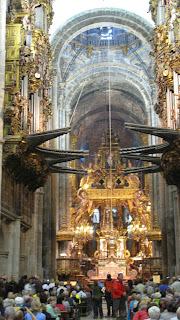When my neighbor, Pat Fages, invited me for a week of walking though Northern Spain I wasn't sure what to think. He became interested in the trek after watching the movie "The Way," starring Martin Sheen. Pat explained that the walk takes the path of an ancient pilgrimage known as the Camino. The only Camino I knew was the Chevy pick-up car of fifty years ago, but because I have always enjoyed my visits to Spain, I thought perhaps a walk through the Spanish countryside might provide me a unique cultural experience. On second thought; walking for days, over hill and dale, through farmers fields, past flocks of sheep and herds of cows - a cultural experience? I wasn't quite sure, but I was intrigued. Why not?, I concluded and told Pat to count me in.
.jpg) I have since learned a great deal about the Camino. Translated to English it's the path or the way and the Camino de Santiago, as it is known, is a pilgrimage through Galicia, a region in the northwest corner of the Iberian peninsula. It purportedly follows the path of the apostle James, who walked through Spain preaching the gospel and evangelizing. The Camino terminates in Galicia's capital city, Santiago de Compostela where the body of St. James is said to be interred. The Way of Saint James has a long, rich history and is based on an incredible story. It's a fable, a miracle or a fabrication, depending upon your interpretation, but in the annals for history, it's had monumental religious and political implications. The story is so compelling, it has motivated the faithful from across Europe for the past thousand years to journey the Way of Saint James. The Camino has become so popular that in 2012 it is reported that 192,488 pilgrims from around the world trekked through Northern Spain to Santiago de Compostela.
I have since learned a great deal about the Camino. Translated to English it's the path or the way and the Camino de Santiago, as it is known, is a pilgrimage through Galicia, a region in the northwest corner of the Iberian peninsula. It purportedly follows the path of the apostle James, who walked through Spain preaching the gospel and evangelizing. The Camino terminates in Galicia's capital city, Santiago de Compostela where the body of St. James is said to be interred. The Way of Saint James has a long, rich history and is based on an incredible story. It's a fable, a miracle or a fabrication, depending upon your interpretation, but in the annals for history, it's had monumental religious and political implications. The story is so compelling, it has motivated the faithful from across Europe for the past thousand years to journey the Way of Saint James. The Camino has become so popular that in 2012 it is reported that 192,488 pilgrims from around the world trekked through Northern Spain to Santiago de Compostela. MY CAMINO
I read that walking the Camino is a simple, straight forward proposition; walk the trail each day, going as far as you like, find lodging, nourishment and rest. Repeat the sequence until arriving at Santiago de Compostela. You carry with you only what you need and there are plenty of food and lodging options available in the villages along the way. There are numerous Camino routes to choose from with the most popular being the "Camino France." It begins in the French town of Saint-Jean-Pied-de Port, 800km from Santiago. That won't work for us, as we don't have a month to Camino. So, Pat, Mike and I will walk the final leg of the Camino Frances covering 111km. That's about 70 miles and exceeds the minimum distance required to earn the compostela or certificate of accomplishment. It will be a mini Camino.
The Camino is a very individual experience. For many it is a pilgrimage, so deeply religious that some pray the rosary or recite novenas while walking. Others find it to be spiritual, a time for reflection or introspection. Yet others see it as nothing more than a healthy life experience. I have no expectations for my Camino and will just take it as it comes. The only thing I know for certain is that I will take the opportunity in Santiago de Compostela to thank God for my life and the opportunities given me.
The Camino is a very individual experience. For many it is a pilgrimage, so deeply religious that some pray the rosary or recite novenas while walking. Others find it to be spiritual, a time for reflection or introspection. Yet others see it as nothing more than a healthy life experience. I have no expectations for my Camino and will just take it as it comes. The only thing I know for certain is that I will take the opportunity in Santiago de Compostela to thank God for my life and the opportunities given me.













.JPG)

























